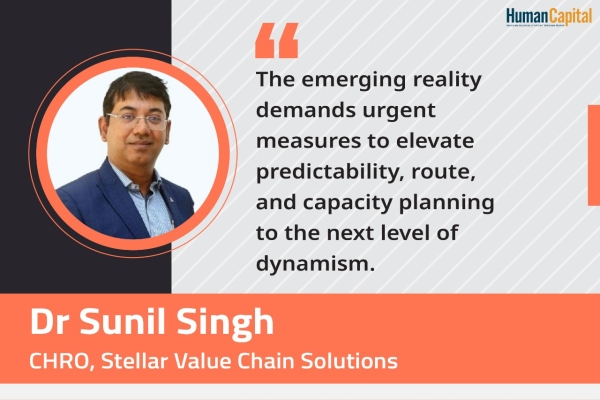As with all other aspects of life, technology is fundamentally transforming the workplace in an unprecedented manner. Emerging technologies such as robotics and AI are dramatically changing the nature of jobs and consequently the skills that organisations are looking for from their people.
In the year 2000, Ray Kurzweil, Futurist and Chief Engineer at Google, predicted that 20,000 years of progress would be crammed into the next hundred. And, true to his prediction, we have witnessed the world changing much faster than ever before. While this change has been catalysed by a number of forces like resource scarcity and climate change, rapid urbanization, shifts in global economic power and demographic changes, the key driver has probably been technological advancement.
As with all other aspects of life, technology is fundamentally transforming the workplace in an unprecedented manner. Emerging technologies such as robotics and AI are dramatically changing the nature of jobs and consequently the skills that organisations are looking for from their people. It is not surprising then, that 92% of global CEOs think technology will change competition in their industry over the next five years, and 52% say that they are already reaping the benefits of humans and machines working together[i]. Then the big question before us is the impact it shall have on the talent and people paradigms. Will technology truly supplement human resources and unleash potential, or will it replace the human mind and put jobs at risk?\
Visualising Digital Transformation
To unravel this question, we may need to visualize digital transformation as three overlapping waves:
1. Wave 1: Assisted intelligence – Here repeatable, standardized and time consuming tasks are automated, allowing humans to concentrate on more strategic tasks. And, this in fact is today’s reality.
2. Wave 2: Augmented intelligence – Here there is a fundamental re-think of business models and the nature of work, enabling humans and machines to collaborate. This wave is emerging in some sectors and organisations today.
3. Wave 3: Autonomous intelligence - This is truly futuristic. Here machines can work on their own and take intelligent decisions.
It is the interplay of these transformative trends that will determine how our future workplace evolves. Two sets of dichotomous forces, emerging predominantly from public sentiment and reaction to technology, will have a significant role to play in this evolution:
1. Collectivism (where fairness and equality dominates) vs. Individualism (where the focus is on individual wants)
2. Corporate integration (where companies become bigger and more influential) vs. business fragmentation (where large businesses lose their dominance and technology driven small organisations gain prominence)
The juxtaposition of these forces will in turn lead to the emergence of future business models with distinct ideologies, competitive approaches, and employee value propositions.
Against such a backdrop, how well the leadership in general, and the Human Resources (HR) function in particular, enables an organisation to transform and transition may truly hold the key to success. While the opportunities in front of the HR function are immense, there are also some challenges to overcome. With humans at the centre of this transformation, HR is today in a unique position to architect the business philosophy and the model of the future. Creating a workplace of purpose, where a multi-generational workforce collaborates with machines and bots to achieve productive, meaningful growth will be the key expectation from HR. HR will also be called upon to develop a culture where diversity and innovation is embraced and where the employee experience drives productivity and commitment.
“With humans at the centre of this transformation, HR is today in a unique position to architect the business philosophy and the model of the future. Creating a workplace of purpose, where a multi-generational workforce collaborates with machines and bots to achieve productive, meaningful growth will be the key expectation from HR. HR will also be called upon to develop a culture where diversity and innovation is embraced and where the employee experience drives productivity and commitment.”
However, this journey will by no means be easy. Organisations and HR will need to overcome significant challenges, the most critical among them being:
1. Availability of skills: For the last few years, CEOs around the world have indicated availability of skills as one of the key challenges they face in their growth journey. It is not surprising then that this year about 87% of Indian CEOs[ii] are also concerned about the availability of key skills. Interestingly, it is not ‘hard’ skills like data analytics or digital capabilities that they find scarce, but rather the ‘softer’ elements like creativity, innovation, adaptability and problem identification that leaders are seeking out. This may require the organisation to significantly relook at their talent acquisition and development processes.
2. Capabilities of leaders: It is paradoxical that many of the individuals who are now responsible for driving digital transformation have been born and bred in an analogue environment. Hence finding and developing the right set of leaders to lead organisations into the future is of critical importance. Leaders who are technologically savvy, yet humane; who are courageous to try new things, yet are resilient to survive; and who are comfortable exercising judgement, while also being data centric, may well be the leadership archetype for the future. Aligning our leadership development architecture with these emerging realities is the need of the hour.
3. Employee anxiety: Change, whether big or small, gives rise to apprehensions in the minds of humans. A recent research conducted by PwC indicates that while 73% of the general public feel that technology can never replace the human mind, 37% are worried about automation putting their jobs at risk.[iii] A two-pronged approach of enabling employees by re-skilling them, while also building a clear narrative which helps them realize that technology is a force for good may be critical in ensuring that the societal ramifications of technology changes are addressed adequately.
“Leaders who are technologically savvy, yet humane; who are courageous to try new things, yet are resilient to survive; and who are comfortable exercising judgement, while also being data centric, may well be the leadership archetype for the future. Aligning our leadership development architecture with these emerging realities is the need of the hour.”
[i] Workforce of the Future: Competing Forces Shaping 2030, PwC, 2017
[ii] 20th CEO Survey: Being Fit for Growth – View from India, PwC, 2017
[iii] PwC survey of 10,029 members of the general population based in China, Germany, India, the UK and the US
Do you look forward to permanently working from home after the pandemic subsides?
Trending
-
SBI General Insurance Launches Digital Health Campaign
-
CredR Rolls Out 'Life Happens' Leave For Its Employees
-
Meesho Announces 30-Week Gender-Neutral Parental Leave Policy
-
Microsoft Unveils Tech Resilience Curriculum To Foster An Inclusive Future
-
60% Indian Professionals Looking For Job Change Due To COVID: Survey
-
SpringPeople And Siemens Collaborate For Digital Transformation Push
-
86% Professionals Believe Hybrid Work Is Essential For Work Life Balance: Report
-
Almost 1 In Every 3 People's Personal Life Affected Due To Work Stress
-
Meesho Rolls Out Reset And Recharge Policy For Employees
-
80% Of Talent Leaders & Academics Say Pandemic Changed Skill Needs For Youth: Report
-
Hero Electric Rolls Out 'Hero Care' Program For Employees
-
Human Capital In Collaboration With ASSOCHAM Hosts Virtual Conference
-
IKEA India, Tata STRIVE Collaborate To Create Employability And Entrepreneurship Opportunities
-
SAP India, Microsoft Launch Tech Skilling Program for Young Women
-
DXC Technology, NASSCOM Collaborate For Employability Skills Program
-
Lenskart To Hire Over 2000 Employees Across India By 2022
-
Mindtree Launches Learn-and-Earn Program
-
Tata AIA Extends 'Raksha Ka Teeka' To Its Employees
-
Swadesh Behera Is The New CPO Of Titan
-
NetConnect Global Plans To Recruit 5000 Tech Professionals In India
-
Hubhopper Plans To Hire 60% Of Indian Podcasters By 2022
-
Corporate India Needs More Women In Leadership Roles: Report
-
Aon to Invest $30 Million and Create 10,000 Apprenticeships by 2030
-
Tech Mahindra Launches ‘Gift a Career’ Initiative for Upskilling of Youth
-
40% Women Prefer Flexible Working Options in Post-COVID World: Survey
-
3 out of 4 companies believe they can effectively hire employees virtually: Report
-
Vodafone , CGI and NASSCOM Foundation launch digital skills platform
-
Odisha: Bank, postal employees to deliver cash for elderly, differently-abled persons
-
Skill India launches AI-based digital platform for "Skilled Workforce"
-
Hiring activity declines 6.73% in first quarter: Survey
-
70% startups impacted by COVID-19 pandemic
-
Bajaj Allianz Life ropes in Santanu Banerjee as CHRO
-
Over 70 Percent MSMEs look at cutting jobs to sustain businesses
-
93 Per Cent employees stressed about returning to office post-lockdown
-
Johnson & Johnson India announces family benefits for same gender partners
-
Indian firms turning friendly towards working mothers
-
Welspun India names Rajendra Mehta as new CHRO
-
Wipro partners with NASSCOM to launch Future Skills platform



Human Capital is niche media organisation for HR and Corporate. Our aim is to create an outstanding user experience for all our clients, readers, employers and employees through inspiring, industry-leading content pieces in the form of case studies, analysis, expert reports, authored articles and blogs. We cover topics such as talent acquisition, learning and development, diversity and inclusion, leadership, compensation, recruitment and many more.
Subscribe Now












































Comment